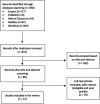Knowledge Gaps in Understanding the Etiology of Anemia in Indonesian Adolescents
- PMID: 34282655
- PMCID: PMC8293751
- DOI: 10.1177/0379572120979241
Knowledge Gaps in Understanding the Etiology of Anemia in Indonesian Adolescents
Abstract
Background: Anemia is a public health problem among adolescents in Indonesia. Strategies to prevent or treat anemia should be tailored to local conditions, taking into account its specific etiology and prevalence in a given setting and population group.
Objective: This review aims to (1) identify and synthesize the current knowledge on the etiology of anemia among adolescents in Indonesia, (2) reveal knowledge gaps in this area, and (3) suggest directions for future research and programmatic work.
Methods: We systematically searched PubMed, Web of Science, Scopus, Medline, and WorldCat databases for peer-reviewed journal articles to identify which etiological factors were related to anemia among Indonesian adolescents. Research papers were reviewed and included in the review according to inclusion criteria.
Results: Of 13 studies, 8 showed that anemia was associated with iron deficiency; 4 are suggestive of vitamin A deficiency; and 2 of folic acid deficiency. Five studies underscore different etiological determinants for anemia, such as malaria, protein and energy malnutrition, vitamin B2 deficiency, calcium, and vitamin C deficiency. Based on these findings, we developed a framework on knowledge gaps on the etiology of anemia among adolescents in Indonesia, divided in 3 levels of knowledge: (1) significant knowledge gaps, (2) knowledge gaps, and (3) established knowledge.
Conclusions: The knowledge gaps around the etiology of anemia among Indonesian adolescents are significant. Our framework emphasizes the need for further research across all etiological factors, namely inadequate nutritional intake and absorption, genetic hemoglobin disorders, infection and inflammation, and menstrual disorders.
Keywords: adolescents; anemia; etiology; hemoglobinopathies; inflammation; micronutrients.
Conflict of interest statement
Figures
Similar articles
-
Nutritional contributors to maternal anemia in Indonesia: Chronic energy deficiency and micronutrients.Asia Pac J Clin Nutr. 2020;29(Suppl 1):S9-S17. doi: 10.6133/apjcn.202012_29(S1).02. Asia Pac J Clin Nutr. 2020. PMID: 33377743
-
Frequent Consumption of Micronutrient-Rich Foods Is Associated With Reduced Risk of Anemia Among Adolescent Girls and Boys in Indonesia: A Cross-Sectional Study.Food Nutr Bull. 2021 Jun;42(1_suppl):S59-S71. doi: 10.1177/0379572120977455. Food Nutr Bull. 2021. PMID: 34282653
-
Micronutrient Deficiencies and Stunting Were Associated with Socioeconomic Status in Indonesian Children Aged 6-59 Months.Nutrients. 2021 May 26;13(6):1802. doi: 10.3390/nu13061802. Nutrients. 2021. PMID: 34073270 Free PMC article.
-
Iron, zinc, vitamin A and selenium status in a cohort of Indonesian infants after adjusting for inflammation using several different approaches.Br J Nutr. 2017 Nov;118(10):830-839. doi: 10.1017/S0007114517002860. Br J Nutr. 2017. PMID: 29189196
-
Nutritional anemia in Indonesia children and adolescents: Diagnostic reliability for appropriate management.Asia Pac J Clin Nutr. 2020;29(Suppl 1):S18-S31. doi: 10.6133/apjcn.202012_29(S1).03. Asia Pac J Clin Nutr. 2020. PMID: 33377744
Cited by
-
The Potential Impact of Dietary Fiber Supplementation on Hemoglobin and Reticulocyte Hemoglobin Equivalent (RET-He) Levels in Pregnant Women with Anemia Receiving Oral Iron Therapy in Indonesia.J Multidiscip Healthc. 2025 Jan 17;18:183-193. doi: 10.2147/JMDH.S497795. eCollection 2025. J Multidiscip Healthc. 2025. PMID: 39844923 Free PMC article.
-
Perceived Barriers and Enablers for Taking Iron-Folic Acid Supplementation Regularly Among Adolescent Girls in Indonesia: A Pilot Study.Int J Environ Res Public Health. 2025 Feb 1;22(2):209. doi: 10.3390/ijerph22020209. Int J Environ Res Public Health. 2025. PMID: 40003435 Free PMC article.
-
Factors associated with anemia among school-going adolescents aged 10-17 years in Zanzibar, Tanzania: a cross sectional study.BMC Public Health. 2023 Sep 18;23(1):1814. doi: 10.1186/s12889-023-16611-w. BMC Public Health. 2023. PMID: 37723498 Free PMC article. Clinical Trial.
-
Impact of pumpkin seeds supplementation on anemia in antenatal mothers at Andhra Pradesh, India.Bioinformation. 2022 Nov 30;18(11):1092-1097. doi: 10.6026/973206300181092. eCollection 2022. Bioinformation. 2022. PMID: 37693080 Free PMC article.
-
Influence of intermittent iron and folic acid supplementation on cognitive abilities among adolescent girls in northwestern Tanzania.PLOS Glob Public Health. 2023 Oct 18;3(10):e0002079. doi: 10.1371/journal.pgph.0002079. eCollection 2023. PLOS Glob Public Health. 2023. PMID: 37851636 Free PMC article.
References
-
- National Institute of Health Research and Development Ministry of Health, Republic of Indonesia. RISKESDAS. Ministry of Health; 2013.
-
- Kraemer K, Zimmermann MB. Nutritional Anemia. Sight and Life Press; 2007.
-
- Kaetelhut A, Schultink W, Angeles I, Gross R, Pietrzik K. The effects of weekly iron supplementation with folic acid, vitamin A, vitamin C on iron status of Indonesian adolescents. Asia Pac J Clin Nutr. 1996;5(3):181–185. - PubMed
-
- Angeles-Agdeppa I, Schultink W, Sastroamidjojo S, Gross R, Karyadi D. Weekly micronutrient supplementation to build iron stores in female Indonesian adolescents. Am J Clin Nutr. 1997;66(1):177–183. - PubMed
-
- Februhartanty J, Dillon D, Khusun H. Will iron supplementation given during menstruation improve iron status better than weekly supplementation? Asia Pac J Clin Nutr. 2002;11(1):36–41. doi:10.1046/j.1440-6047.2002.00264.x - PubMed
Publication types
MeSH terms
Substances
LinkOut - more resources
Full Text Sources
Medical



